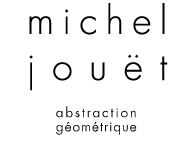LE FIL A PLOMB D’ARIANE
On pourrait assimiler le travail de Michel Jouët à un parcours initiatique, ne le voit-on pas dès 1967 dérouler son fil d’Ariane à travers le labyrinthe des craquelures, exploiter ensuite les fissures du bois, suivre la dispersion solsticiale des meules de foin ou traquer la géométrie aléatoire de traces d’avion (« Plane Trails », 1991) dans le ciel – suite logique – Comme Icare, il fait le dédale pour s’élancer à l’assaut de la voûte céleste, vaincre la terrible pesanteur et confirmer le Corbusier qui disait que toute construction doit se faire « en verticale dans le ciel ». Ainsi dès 1987, l’artiste jette un fil lesté entre ciel et terre.
En 1992, Michel Jouët réalise une toile carré blanche d’un mètre sur un mètre : au centre deux horizontales noirs peintes et au sommet deux tenons permettent de poser une corde lestée de deux fil à plomb, cette corde blanche segmentée de deux traits noirs coulisse au gré de l’amateur et forme (les traits noirs horizontaux ayant la même longueur que les segments noirs de la corde) un carré central, des angles droits ou des taus. La proposition est simple, le jeu formel s’additionne d’une poésie indéniable et la solution plastique se hisse de la géométrie à la philosophie.
Avec son double fil à plomb, Michel Jouët illustre à merveille la force perpendiculaire qui gère l’espace, la surface et la spiritualité.
L’artiste échappe dorénavant à l’aléa formel – ab Chao – pour passer de la perpendiculaire au niveau.
Michel Jouët trace des lignes essentielles et arpente l’espace dans une dualité en noir et blanc.
Au-delà de la plastique construite (à laquelle manque parfois la cohérence d’un discours), l’artiste atteint ici une symbolique universelle.
Ben Durant
Historien de l’art, galeriste
Bruxelles janvier 1994
ARIADNE’S PLUMB LINE
Michel Jouët’s work could be likened to an initiatory journey – since 1967 have we not seen him unwinding his Ariadne’s thread in a maze of cracks, then going on to make use of the fissures in wood, to follow the scattering of haystacks at the solstice, or track the random geometry of the trails planes leave in the sky (‘Plane Trails’, 1991)? The next step is logical – like Icarus, after the labyrinth, he launches his attempt on the heavenly vault, striving to defeat the horror of weight and prove that Corbusier was right when he said that every construction must rise ‘vertically into the sky’. Thus, since 1987, the artist has been casting a weighted thread between sky and earth.
In 1992 Michel Jouët made a metre-square white canvas: in the middle were painted two black horizontal lines, and at the top were two hooks into which could be fitted a cord weighted with two plumb lines, the white cord – divided by two black lines – slides as the viewer wishes, and (the black horizontals being the same length as the black segments of the cord) forms a central square, right angles or crosses. The proposition is simple: an undeniable poetry is added to the formal play, and the plastic creation rises from geometry to philosophy.
With his double plumb line Michel Jouët gives a wonderful demonstration of the perpendicular force exerted on space, surface and spirituality.
Thereafter the artist escapes the dangers of the formal – escapes from chaos – to pass from the perpendicular to the level.
Michel Jouët draws the essential lines, and traverses space in a black and white duality.
Going beyond plastic construction (which can sometimes lack the coherence of a discourse) the artist here achieves a universal symbolism.
Ben Durant, art historian and gallery-owner – Brussels, January 1994
